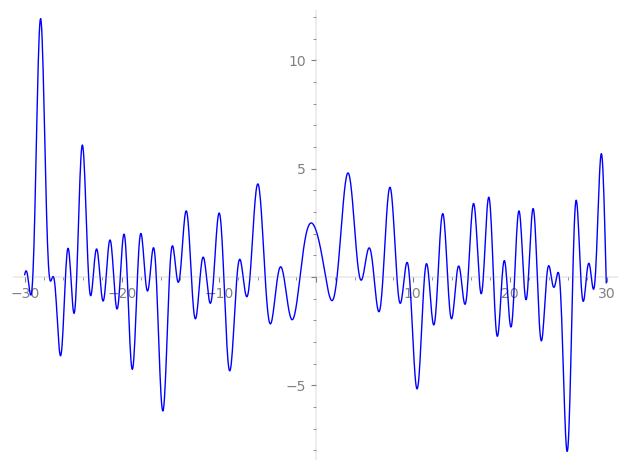| L(s) = 1 | + (0.417 − 0.417i)2-s + 3.65i·4-s + (−0.0756 + 4.99i)5-s + (7.04 − 7.04i)7-s + (3.19 + 3.19i)8-s + (2.05 + 2.12i)10-s + 15.2·11-s + (−9.18 − 9.18i)13-s − 5.89i·14-s − 11.9·16-s + (5.30 − 5.30i)17-s + 32.8i·19-s + (−18.2 − 0.276i)20-s + (6.38 − 6.38i)22-s + (24.9 + 24.9i)23-s + ⋯ |
| L(s) = 1 | + (0.208 − 0.208i)2-s + 0.912i·4-s + (−0.0151 + 0.999i)5-s + (1.00 − 1.00i)7-s + (0.399 + 0.399i)8-s + (0.205 + 0.212i)10-s + 1.38·11-s + (−0.706 − 0.706i)13-s − 0.420i·14-s − 0.745·16-s + (0.312 − 0.312i)17-s + 1.72i·19-s + (−0.912 − 0.0138i)20-s + (0.290 − 0.290i)22-s + (1.08 + 1.08i)23-s + ⋯ |
\[\begin{aligned}\Lambda(s)=\mathstrut & 405 ^{s/2} \, \Gamma_{\C}(s) \, L(s)\cr =\mathstrut & (0.538 - 0.842i)\, \overline{\Lambda}(3-s) \end{aligned}\]
\[\begin{aligned}\Lambda(s)=\mathstrut & 405 ^{s/2} \, \Gamma_{\C}(s+1) \, L(s)\cr =\mathstrut & (0.538 - 0.842i)\, \overline{\Lambda}(1-s) \end{aligned}\]
Particular Values
| \(L(\frac{3}{2})\) |
\(\approx\) |
\(1.92247 + 1.05286i\) |
| \(L(\frac12)\) |
\(\approx\) |
\(1.92247 + 1.05286i\) |
| \(L(2)\) |
|
not available |
| \(L(1)\) |
|
not available |
\(L(s) = \displaystyle \prod_{p} F_p(p^{-s})^{-1} \)
| $p$ | $F_p(T)$ |
|---|
| bad | 3 | \( 1 \) |
| 5 | \( 1 + (0.0756 - 4.99i)T \) |
| good | 2 | \( 1 + (-0.417 + 0.417i)T - 4iT^{2} \) |
| 7 | \( 1 + (-7.04 + 7.04i)T - 49iT^{2} \) |
| 11 | \( 1 - 15.2T + 121T^{2} \) |
| 13 | \( 1 + (9.18 + 9.18i)T + 169iT^{2} \) |
| 17 | \( 1 + (-5.30 + 5.30i)T - 289iT^{2} \) |
| 19 | \( 1 - 32.8iT - 361T^{2} \) |
| 23 | \( 1 + (-24.9 - 24.9i)T + 529iT^{2} \) |
| 29 | \( 1 - 36.3iT - 841T^{2} \) |
| 31 | \( 1 + 1.39T + 961T^{2} \) |
| 37 | \( 1 + (-15.9 + 15.9i)T - 1.36e3iT^{2} \) |
| 41 | \( 1 - 10.2T + 1.68e3T^{2} \) |
| 43 | \( 1 + (36.7 + 36.7i)T + 1.84e3iT^{2} \) |
| 47 | \( 1 + (8.44 - 8.44i)T - 2.20e3iT^{2} \) |
| 53 | \( 1 + (42.9 + 42.9i)T + 2.80e3iT^{2} \) |
| 59 | \( 1 + 0.115iT - 3.48e3T^{2} \) |
| 61 | \( 1 - 4.25T + 3.72e3T^{2} \) |
| 67 | \( 1 + (-42.8 + 42.8i)T - 4.48e3iT^{2} \) |
| 71 | \( 1 - 64.5T + 5.04e3T^{2} \) |
| 73 | \( 1 + (-12.7 - 12.7i)T + 5.32e3iT^{2} \) |
| 79 | \( 1 + 13.6iT - 6.24e3T^{2} \) |
| 83 | \( 1 + (22.4 + 22.4i)T + 6.88e3iT^{2} \) |
| 89 | \( 1 - 68.7iT - 7.92e3T^{2} \) |
| 97 | \( 1 + (10.6 - 10.6i)T - 9.40e3iT^{2} \) |
| show more | |
| show less | |
\(L(s) = \displaystyle\prod_p \ \prod_{j=1}^{2} (1 - \alpha_{j,p}\, p^{-s})^{-1}\)
Imaginary part of the first few zeros on the critical line
−11.26164219996965416437898752209, −10.52013192409393182438115341177, −9.473945400770952514240128525730, −8.122591224548711623667368070538, −7.48038139435931807798602033262, −6.77859909074132287527898389121, −5.21104725575593051625226204361, −3.92880116819579210305625945478, −3.28211000699753886301087426875, −1.62318013914638854887966657450,
1.01884897897469706079676568379, 2.19825934509886808581872747117, 4.52595340960428101399184002456, 4.84828437503201136384518134759, 6.01037299040161018741684223498, 6.93475566712549351338377087286, 8.367739428139324780213634212419, 9.134698741331404489700104471352, 9.662182568040625522619271895872, 11.21128712297265834766332199731

